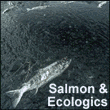forum
library
tutorial
contact

Spring Chinook Fishing Extended to April 14,
Sport Catch by April 7 Expected to be under 3,000 Fish
by Staff
Columbia Basin Bulletin, April 4, 2014
|
the film forum library tutorial contact |

|
Spring Chinook Fishing Extended to April 14,
by Staff
|
Spring chinook anglers on the lower Columbia River will get at least six more days of salmon fishing under a season extension adopted Thursday by Oregon and Washington fishery managers.
The spring chinook season that was originally scheduled to close after April 7 will now go through April 14, except for Tuesday, April 8, when the recreational fishery will be closed to allow for a potential commercial fishing period.
High and turbid water conditions meant a slow beginning to the spring chinook season. Through March 31, anglers have harvested only 5 percent of their available upriver spring chinook allocation.
The extension will give anglers another chance to catch hatchery-reared spring chinook still available for harvest, said Ron Roler, Columbia River policy coordinator for the Washington Department of Fish and Wildlife.
"Fishing conditions on the Columbia River have been pretty rough in recent weeks," Roler said. "These extra fishing days will give anglers some time to make up for the high, turbid river conditions that have held the sport catch well below the harvest guideline."
"River conditions have been improving and we hope that trend continues next week," Roler said.
Upriver spring chinook are fish bound for hatcheries and spawning grounds upstream of Bonneville Dam, which is located about 146 miles from the mouth of the Columbia River at the Pacific Ocean. The spring chinook harvest is limited in order to hold down impacts on wild Upper Columbia and Snake River stocks that are protected under the Endangered Species Act.
Managers predict that by April 7 anglers' kept catch will be fewer than 3,000, only a quarter of the 12,400-fish pre-season expectation.
The upriver spring chinook numbers are just starting to build. Through Wednesday a total of 620 had reached Bonneville. The total last year through April 2 was 402 adult fish, and the 10-year average through that date is 271.
Water conditions and fish abundance are expected to improve over the next week and a half.
According to Jeff Whisler, ODFW's assistant Columbia River fisheries manager, staff is predicting that by the end of the season extension 89 percent of the fishery's allocation of upriver spring chinook will be used. That allocation is based on the preseason forecast for upriver spring chinook salmon returns to the mouth of the Columbia. That forecast is for a return of 227,000 adult fish, which would be the fifth highest return since 1980 and 129 percent of the average return observed over the past decade (2004-2013).
However, Whisler cautions that predicting the number of fish that will be caught during the six day extension is difficult and anglers should be alert for further modifications to the fishery.
Over the next week, the states will continue to closely monitor the salmon returns and recreational catch to determine whether further modifications to the spring chinook season are appropriate. In-season regulation changes are posted on the ODFW web site.
The bag limits and areas open to fishing remain the same during the extension: From Buoy 10 near the river mouth upstream to Beacon Rock (boat and bank) plus bank fishing only from Beacon Rock upstream to the Bonneville Dam deadline. Anglers may keep two adult salmonids a day, of which only one may be a chinook. Only adipose fin-clipped fish may be kept.
The Columbia River Compact on Monday approved an eight-hour non-tribal commercial fishery on the lower Columbia on Tuesday, the first such outing approved this year. The Compact is made up of representatives of the Oregon and Washington department of fish and wildlife directors. The panel sets Columbia mainstem commercial fisheries along the stretch of river that represents the states' border.
A majority of commercial fishermen testifying the previous week declined an outing proposed for March 25, saying high flows and murky waters, and a predicted storm, made that fishery unfeasible. They also cited the need to await the arrival of higher numbers of spring chinook, and the dispersal of winter steelhead.
The incidental catch of winter steelhead is avoided because high mortality can force gill-netters off the water. The incidental "take"--mortality -- of listed steelhead is limited.
The commercial fleet did do reasonably well during this week's fishery, however. Data posted online at ODFW's web site indicates that 1,705 spring chinook, averaging about 12.5 pounds per fish, were caught and sold. The ODFW and WDFW staffs had estimated that the kept catch would be 1,900 chinook.
During the Thursday sport hearing state staff said that the commercial catch consumed roughly 85 percent of the non-tribal gill-netters' allowable harvest of upriver spring chinook. State management agreements now in place allow the harvest of up to 1,735 upriver spring chinook during the early part of the season. That allotment represents 60 percent of the allowed harvest should the upriver spring chinook return be as forecast.
That buffer is in place until fishery managers can better ascertain the actual run size. Forecasts will be updated, likely in early May, when roughly half of the year's run has been judged to have passed over Bonneville. A 30-percent buffer is in place for the sport fishery.
"There are about 300 fish available from what we can tell" the WDFW's Robin Ehlke told the sport panel.
learn more on topics covered in the film
see the video
read the script
learn the songs
discussion forum
